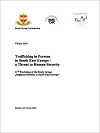Trafficking in Persons in South East Europe - a Threat to Human Security
11th Workshop of the Study Group
Dokumenttyp:
Study Group InformationErscheinungsdatum:
August 2006Herausgeber:
Prof. Dr. Ayse Nilufer Narli, Col Mag. Ernst M. FelberbauerVerlag:
Study Group Information - Austrian National Defence Academy in co-operation with the PfP Consortium of Defense Academies and Security Studies InstitutesISBN:
3-902456-57-4Seiten:
138Autor(en):
Akif Ayhan, Katerina Badikova, Nadya Dimitrova, Sueda Elif Tuba Dündar, Basak Kale, Prof. Dr. Ayse Nilufer Narli, Ladan RahmaniBeiträge in dieser Publikation:
Vorwort
Introduction
During the past decade, human trafficking and smuggling grew to a diverse multibillion dollar business across South East Europe and the entire globe. The concern about human smuggling and trafficking extends far beyond matters of security and law enforcement. The cost in human suffering and exploitation that often accompanies smuggling and trafficking cause human rights violations and deplete human capital in origin countries.
The Regional Stability in South East Europe Study Group of the PfP Consortium of Defence Academies and Security Studies Institutes decided to asses the situation in the South East European region in its 11th Workshop on "Combating Trafficking in Persons in SEE - a Threat to Human Security”, jointly organized by the International Organization on Migration (IOM), and the Center for Strategic Research at the Turkish Ministry of Foreign Affairs of Turkey from 25-27 August 2005 in Istanbul.
The main objective of the workshop was to discuss human security approach to trafficking in general, and in the particular context of trafficking in persons to and from SEE. Herein, it focused on: the policy, practice and human security threats posed by trafficking in persons; the human rights of trafficking victims, especially in destination countries that may include the right to temporary residence permits, assistance, etc; law enforcement aspects, such as investigative techniques, witness protection mechanisms and cross-border collaboration; and the link between trafficking and various forms of organized crimes.
The book explores the regional dimensions of human trafficking and smuggling in several forms in the South East Europe. It examines the deep social, economic, and cultural roots of human trafficking and smuggling and their broad political consequences.
In the book, a number of articles analyse the diversity of human smuggling of migrants, the international business of trafficking women, asylum-seekers, and those who are tricked into slavery. Some of them look more closely at the legal construction of victimized women trafficked into slavery and new laws in several states, the creation and expansion of new enforcement and management agencies in the region to combat human smuggling.
The case studies presented in the book show that human smuggling differs from trafficking only by degree. Smuggling organizations make their profits by illegally moving humans to countries of their choice. Traffickers, however, increase their profits by forcing their victims into forced labor or commercial sexual exploitation arrangements at their destinations. Trafficking also often involves exploitation of agricultural employees and shop workers, as well as individuals working as domestic servants. The perpetrators of trafficking are not restrained by conscience. Their methods are devious, exploitative, and ruthless. Their victims include the young and the vulnerable. The depravity of their actions tests - and often far exceeds - the boundaries of decency. Traffickers prey on the economically disadvantaged and on those who lack social safety nets.
Traffickers lure victims from their homes with false promises of economic opportunities and better lives. Naturally, less-developed countries with high rates of poverty, violence, and corruption constitute their best recruiting bases. South East Europe, East Asia, and Latin America are the largest source of trafficking victims.
International and regional cooperation is very important to combat human trafficking and smuggling. At the national level, taking legal measures and action to prevent human trafficking and raising awareness of the human trafficking phenomenon, particularly that of women trafficking are very important.
Turkey, one of the major transit countries in the region, adopted new laws and policies to prevent human smuggling and trafficking. It also outlawed organ trafficking when the Parliament adopted a major reform package to harmonize Turkish laws with those of the EU in August 2002.
Turkey signed the UN Convention on transnational organized crime and its two Protocols regulating migrant smuggling and human trafficking (Palermo Documents) in 2000 and ratified them in Turkish Parliament (TGNA) in 2003. The Turkish General National Assembly amended Turkish Penal Code and human trafficking is defined as a crime in 2002, which sentences the perpetrators 5 to 10 years. A new Turkish Penal Code was passed in 2005 and it sentences human trafficking from 8 to 12 years.
Nilufer Narli



